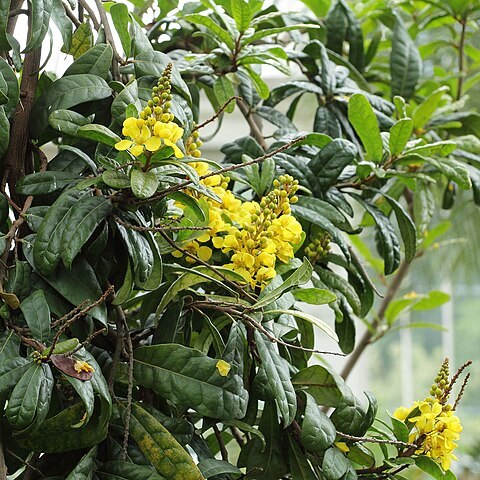Leaf-lamina 7–12 (15) × 0·5–4·5 cm., oblong, oblanceolate, oblong-ovate, oblong-oblanceolate, linear or linear-lanceolate, apex obtuse, subobtuse, or acuminate, base cuneate, rarely rounded, mostly quite glabrous on both surfaces (younger ones sometimes ± pubescent), coriaceous, with 7–11 pairs of lateral nerves beneath, somewhat reticulate, with usually 2 (4) glands at the very base beneath; petiole stout, 2 (5)–10 (13) mm. long, canaliculate, usually glabrous.
Inflorescences 5–15 (25) cm. long, of many-flowered racemes terminating leafy branches, very rarely axillary, pyramidal in outline; bracts up to 5 mm. long, subulate, persistent, eglandular; bracteoles 1–2·5 mm. long, subulate, eglandular.
Calyx-lobes 3·5–5 mm. long, 2–2·5 mm. broad, broadly ovate to ovate, glabrous or rarely sericeous outside, the 2 anterior ones usually with 2 glands affixed near the edges above the base.
Samara with wing up to 3 (4) × 1·7–2·2 cm., broadly obliquely ovate, with the upper margin straight, rarely slightly curved, distally obtuse, surrounding the nut to the base.
Small tree or shrub up to 5 m. in height, sometimes scrambling or climbing; stems with younger parts bright yellow-or reddish-sericeous, older ones glabrous, lenticellate.
Stamens with anthers c. 5 mm. long, lanceolate or lanceolate-oblong; filaments 2–2·5 mm. long, glabrous.
Petals 10–15 mm. long, subcircular, yellowish, ± lacerate, shortly unguiculate, claw c. 2 mm. long.
Ovary densely hairy; styles ± 1·5 mm. long, curved inwards.
Flowers 2–3·3 cm. in diam.


